#biblical keys to Divine power
Explore tagged Tumblr posts
Text
7 Biblical Keys to Unleashing Divine Power Through Prayer and Consecration
#christianpodcast#biblical keys to Divine power#Divine power#God's power#prayer#consecration#kingdomcomepodcast#kingdomcomepodcastwithandrewnkoyoyo#dr. andrew nkoyoyo#jesus christ#christianity#holy spirit#prayerofconsecration#propheticmessage2025#kingdom impact ministry
0 notes
Text
Manifestation as a Christian: A Comprehensive Biblical Guide

Manifestation, the practice of bringing one's desires into reality through positive thinking, visualization, and affirmations, has gained significant attention in contemporary culture. For Christians, understanding and utilizing manifestation within a biblical framework can provide a powerful and faith-anchored approach to achieving goals and experiencing blessings. This guide explores the biblical basis for manifestation, aligns it with scriptural teachings, and offers practical steps for Christians to use manifestation while remaining rooted in their faith.
Biblical Basis for Manifestation
Faith and Belief
The Bible emphasizes the power of faith and belief, which are core components of manifestation:
Hebrews 11:1 - "Now faith is the substance of things hoped for, the evidence of things not seen."
Mark 11:24 - "Therefore I tell you, whatever you ask in prayer, believe that you have received it, and it will be yours."
The tenent highlighted in these verses shows us the importance of believing in what you ask for, reflecting the foundational principle of manifestation which many may refer to as "Law of Assumption" that faith and belief are crucial to bring things forward into reality.
Positive Confession
The Bible also teaches the power of words and the importance of speaking positively, as our words have immense power to bring forward good but also evil into our lives:
Proverbs 18:21 - "Death and life are in the power of the tongue, and those who love it will eat its fruits."
Romans 4:17 - "As it is written, ‘I have made you the father of many nations’—in the presence of the God in whom he believed, who gives life to the dead and calls into existence the things that do not exist."
Our words shape our reality, it's crucial that we become aware of this, so as to not allow corrupt talk to come out of our lips.
God’s Will and Alignment
Understanding and aligning with God’s will is essential in the manifestation process:
1 John 5:14-15 - "And this is the confidence that we have toward him, that if we ask anything according to his will he hears us. And if we know that he hears us in whatever we ask, we know that we have the requests that we have asked of him."
Matthew 6:33 - "But seek first the kingdom of God and his righteousness, and all these things will be added to you."
These verses stress the importance of aligning our desires with God's will, ensuring that our manifestations are in harmony with His divine plan, which as we will see further below, are plans to prosper us and give us a future to look forward to.
Understanding Manifestation Biblically
God as the Source
In biblical teaching, God is the ultimate source of all provision and blessing. While contemporary manifestation often emphasizes the individual's power to attract or create their reality, the Bible underscores that all good things come from God:
James 1:17 - "Every good gift and every perfect gift is from above, coming down from the Father of lights with whom there is no variation or shadow due to change."
Prayer and Supplication
Believers are encouraged to bring their desires and needs to God through prayer and supplication, acknowledging their dependence on Him:
Philippians 4:6-7 - "Do not be anxious about anything, but in every situation, by prayer and petition, with thanksgiving, present your requests to God. And the peace of God, which transcends all understanding, will guard your hearts and your minds in Christ Jesus."
Gratitude and Thanksgiving
Gratitude is a key element in both biblical teaching and modern manifestation practices. Giving thanks, even before receiving what has been asked for, reflects faith and trust in God’s provision:
1 Thessalonians 5:18 - "Give thanks in all circumstances; for this is the will of God in Christ Jesus for you."
Action and Faith
Manifestation involves not just belief but also taking actionable steps towards one’s goals. The Bible supports the idea that faith should be accompanied by corresponding actions:
James 2:26 - "For as the body apart from the spirit is dead, so also faith apart from works is dead."
Ensuring Good Things by Being Anchored to God
Confidence in Prayer
1 John 5:14-15 can be connected with Jeremiah 29:11 to emphasize the assurance of God’s good intentions for us. Jeremiah 29:11 states:
Jeremiah 29:11 - "For I know the plans I have for you, declares the Lord, plans to prosper you and not to harm you, plans to give you hope and a future."
God's will is to prosper us and give us hope and a future. Therefore, when we pray in alignment with these good plans, we can be assured that God hears and answers our prayers. And when we pray with the assurance of knowing that these things we ask will come to pass, we exercise extreme faith, which is pleasing before God.
Assurance of God’s Good Plans
Knowing that God's plans are to prosper us and not to harm us provides reassurance that He will only allow what is ultimately for our benefit. Even when we face challenges or things don't go as we planned, we can trust that God’s ultimate purpose is for our good and better things are on their way:
Romans 8:28 - "And we know that in all things God works for the good of those who love him, who have been called according to his purpose."
Sometimes what we desire may not come to pass immediately or in the way we expect. Trusting in God’s wisdom and timing is crucial.
Manifestation as a God-Given Tool
Gift of Manifestation
Manifestation can be seen as a God-given tool that allows us to participate in bringing forth blessings and positive outcomes in our lives:
Genesis 1:27 - "So God created man in his own image, in the image of God he created him; male and female he created them."
Being made in God's image implies that we have creative power and the ability to influence our reality. There is no greater creator than God, all creation comes from Him, and by being made in his own image, we carry the power to create with us as well.
Anchored in God
When we anchor our manifestation practices in God, we align our desires and actions with His will:
Proverbs 3:5-6 - "Trust in the Lord with all your heart, and do not lean on your own understanding. In all your ways acknowledge him, and he will make straight your paths."
Seeking God’s guidance and wisdom helps us discern what is truly beneficial for us:
James 1:5 - "If any of you lacks wisdom, let him ask of God, who gives to all liberally and without reproach, and it will be given to him."
Protection from Harm
When we manifest with God, we trust Him to protect us from things that might seem good but could ultimately harm us, because ultimately we are bringing forward His will for us, which as we've seen, can only be for our benefit:
Romans 8:28 - "And we know that in all things God works for the good of those who love him, who have been called according to his purpose."
Manifestation, when viewed as a tool given by God, becomes a powerful practice that brings blessings and positive outcomes into our lives. By anchoring ourselves in God and surrendering our desires to Him, we ensure that only good things come our way. This approach integrates the power of positive thinking and faith with a deep trust in God's perfect will and timing. By understanding and believing that God's will is inherently good and designed for our benefit, we can approach Him with confidence, knowing that He will fulfill His promises to prosper us and give us hope and a future.
137 notes
·
View notes
Text
Studying biblical verses to read when struggling with spiritual warfare p.2 : Psalm 91
(NLT) Psa 91 - “Those who live in the shelter of the Most High will find rest in the shadow of the Almighty. This I declare about the LORD: He alone is my refuge, my place of safety; he is my God, and I trust him. For he will rescue you from every trap and protect you from deadly disease. He will cover you with his feathers. He will shelter you with his wings. His faithful promises are your armor and protection. Do not be afraid of the terrors of the night, nor the arrow that flies in the day. Do not dread the disease that stalks in darkness, nor the disaster that strikes at midday. Though a thousand fall at your side, though ten thousand are dying around you, these evils will not touch you. Just open your eyes, and see how the wicked are punished. If you make the LORD your refuge, if you make the Most High your shelter, no evil will conquer you; no plague will come near your home. For he will order his angels to protect you wherever you go. They will hold you up with their hands so you won’t even hurt your foot on a stone. You will trample upon lions and cobras; you will crush fierce lions and serpents under your feet! The LORD says, “I will rescue those who love me. I will protect those who trust in my name. When they call on me, I will answer; I will be with them in trouble. I will rescue and honor them. I will reward them with a long life and give them my salvation.”
Psalm 91 is a powerful and comforting passage that speaks of God's protection and deliverance . Here’s a summary and explanation of its key themes:
• Promise of safety (verses 1-2) :
It is said that those who maintain a close, trusting relationship with God will find safety and rest under His protection. Our Lord is portrayed as a refuge and a shelter, providing security and comfort to those who are close to Him.
• Protection from dangers (verses 3-8) :
It is true that God promises to rescue from hidden dangers and deadly diseases. His protection is depicted as covering with feathers and sheltering under wings, symbolizing tender care and safety. In other words, it is said that the faithful are shielded from harm and deceit.
• Freedom from fear (verses 9-13) :
In fact, those who trust in God will not be overcome by evil or disease. Angels are assigned to guard and protect, reinforcing the idea of divine oversight. Therefore it is assured that harm will not reach those who make God their refuge.
• God’s response to faithfulness (verses 14-16) :
Certainly, God will deliver and honor those who love and trust Him. God will answer prayers, be present in trouble, and grant long life and salvation ; a divine reward for steadfast faith and trust.
• In summary, Psalm 91 promises that those who trust in the Lord will find safety and protection from dangers and fears. God will deliver them from harm, shield them with care, and honor their faithfulness with long life and salvation.
Have a Blessed day 🙏
#bibletruth#christian blog#christian faith#christian living#christianity#faith in god#faith in jesus#god is love#jesus christ#jesus is coming#holy bible#bible#bible scripture#christian bible#bible quote#bible study#bible reading#bible verse#psalms#psalm 91#jesus loves you#jesusisgod#i talk to jesus#jesusislord#jesussaves#jesus#christian girl#christian tumblr#godisgood#god is kind
140 notes
·
View notes
Text
take me up / cast me away
so this is going to be a veritable word vomit but this is actually so exciting to me; we obviously affiliate aziraphale with the flaming sword and both its biblical and GO narrative implications, but the catch that @frog-person made on this particular shot has got every synapse firing.
(and therefore this is a meta for @frog-person and them only, mwah✨💕)

not only is the sword going through their hands, but it's one sword of many in a particularly fiendish magic trick (or at least an earlier version of one made popular by the morettis in the 70s), and the box itself with all of its swords is relatively prominent in most of the scene, as background props go (more on this later).
now, i don't know enough about magic tricks or illusions to understand the significance that this aspect may have, if any - possibly the element of trust, sure, but also the sheer ability to hoodwink the audience into accepting that there is no way that whatever is inside could possibly survive such a trick. however, i simply want to just talk about the sword in general.
let's start with connotations and symbolism behind the image of the sword. first of all, it's a phallic symbol and is largely used in the context of knighthood, chivalry, and sovereignty. it symbolises justice, and truth, and righteous and merciful power. to hold the meter of life and death in your hands, and to be trusted to use it in conscience and clemency.
in alchemy, the sword was shown as a symbol of purification, between life and death. similar connotations in other histories, literature, and customs read the sword as being the key to balance between truth and enlightenment. later into history, especially in the middle ages, swords of discernible quality were understandably resource-intensive to make and therefore came to symbolise wealth, but moreso in the context of strength and glory, and further then a symbol of protection and shelter. traditionally, oaths and pledges would be made to the sword (literally, sworn-sword), and in turn swords were - and continue to be - used to elevate you to a higher station (eg. use of a knighting sword).
the imagery of the sword in the box is evocative of the sword excalibur, probably one of the most famous swords in literature and legend. cliff notes: excalibur was the believed magical sword of king arthur, and was written in some accounts (specifically in this case in the poem Merlin by robert de boron) to have lodged in an anvil, sat atop a stone, and that whoever could pull it from the anvil would be proof of rightful lineage of uther pendragon - and therefore, by divine right, king of the britons. obviously, arthur was said to have pulled the sword from the stone.
excalibur's symbolism can be interpreted somewhat as being as i said above; tennyson wrote that the words inscribed on excalibur as being (paraphrased): "take me up" / "cast me away"; to indicate that the sword is a weapon that should be used sparingly, only when necessary, and never without mercy or fair judgement. it is a power that can destroy, and should be safeguarded from turning that power to insidiousness. a call-to-arms when taken up, and a grace and peace when cast away.
(im a whore for arthurian legend ok, im from southwest uk) (and have a tattoo on my arm of those words, im a basic cornish legend bitch)
now, i realise that excalibur is not literally a part of the GO story (that we know of, notwithstanding the flashback in s1), and the sword we know in GO has a rather different narrative importance (or does it?). so, we know that in genesis the flaming sword was given to the cherubim in eden to guard adam and eve, and this is pretty much transposed to GO right up until aziraphale does the Cool Thing and gives it away, meant as a means of protection.
however, given that it ends up in the hands of humanity's personification of war, it bears a rather vivid mirror to the intention of excalibur; that in casting it away, aziraphale inadvertently introduces the concept of destruction to humanity.
but im now going to move away from the symbolism of the sword itself (i promise im trying to organise this meta into some semblance of order), and instead look at it in terms of when aziraphale actually holds it. we start with him giving it to adam and eve:

and then when he takes it up at the airfield:

and in the time bubble with adam and crowley:

now this is really obvious, i realise, but it does have some bearing for me on the image we see in the 40s minisode. sword up: ready to fight. sword down: ready to rest. it's a reasonably common occurrence to see in heraldry (by extension in logos/emblems and even on gravestones) two crossed swords pointing up or pointing down. usually, for the former, that the prospective wielder is ready to battle, is prepared and willing, and is or always has been braced for the onslaught.
the latter however indicates that either the fighting is done, or that no threat is meant - and that this can be in death, in surrender or defeat, or out of conscientious choice. that the wielder may have chosen mercy, and to act with peace and without conflict. one step further - sheathed sword goes on to symbolise that a fight is not anticipated; not necessarily in the sense that the wielder is unprepared, but instead that they are not turning to violence as an option.
this is where i think the presence of the sword in the shots from the minisode, with all of the connotations of it from eden (and its similar, in my eyes, likeness to excalibur) come into play. as i said before, the sword/s are notable visually in the whole magic shop scene. its in primary focus along with the desk as they enter, its the first display aziraphale goes towards, and it oscillates in the background from to aziraphale's right, to between him and crowley, and latterly back again:




summarised thoughts on this, because it will otherwise be a truly garbled mess:
the sheer presence of it reminds the audience that a fight may be imminent, even if the scene/story is currently at peace
that whilst the narrative is not currently in full combat, it pays heed to not only the events of ep4 being somewhat of a fight, but the events that precipitate in ep5 and ep6, and leading into s3
that where it is currently cast in the figurative stone, it may be called upon to take up arms, and confer suggestions of sovereignty, divine power, and strength
that victory (however that may conclude) may only be possible with the right person in power; aziraphale as the new supreme archangel and prince of heaven
it also confers the necessity of protection, of justice, and of mercy, being elevated to a position where you have the power to make that judgement
all things which aziraphale intended by giving away his own sword, and is what he indicates in ep6 that he intends to deliver to heaven once he ascends
that this fight, whenever it may come, may literally divide him and crowley in the story that lies ahead
...you don't need me to explain this bit contextually, right?

the last thing that stumped me, however, is that there ought to have been something in ep6 that almost bookended all of this imagery (at least temporarily, until we have a s3), or at least indicated whether or not aziraphale chooses to take up the sword again like he does at the end of s1. that shows him prepared for a fight, to defend the weak, and uphold judgement in mercy... and then it hit me:

of course there bloody is.
#this is relatively unimportant and unneeded but this my shit#like do i believe that ive cracked a code and this was what neil intended to convey? no not necessarily#but do igaf and instead just like going full year 9 english teacher on this shit? absolutely#not proof read yet - pretend you do not Perceive The Errors#good omens#s2 meta#s1 meta#flashback meta#aziraphale meta#s3 narrative spec
190 notes
·
View notes
Text
Not too long ago I rambled about how Leander, Ais, and Mhin might be representing each of the three moons in the Triple Goddess Symbol and what that could imply about the Touchstarved routes. I left out Kuras and Vere since it’s, well, the Triple Goddess Symbol… but I wanna talk about them now. Leander, Ais and Mhin are connected, but so are Kuras and Vere.
Just in a different way: they’re foil characters.
A foil character is essentially a literary device in which writers highlight a character’s traits (be it their personality, appearances, or philosophies) with another character who has traits that are opposite to them. But this is not to say that they’re complete opposites or made to be protagonist vs antagonist. They can be similar in some ways like two sides of the same coin. For example, Sherlock and Watson are popular foil characters. Both are intelligent, but in different ways. Sherlock is the logical type of intelligence while Watson is emotionally intelligent. They’reboth friends, but they also challenge each other with their philosophies and methodology.
I feel like that is also the case with Kuras and Vere. Though they are far from friends, I do believe that they were designed to be foil characters and possibly challenge each other whether that be as rivals, foes or eventually– friends. Am I coping? Maybe. But hear me out:
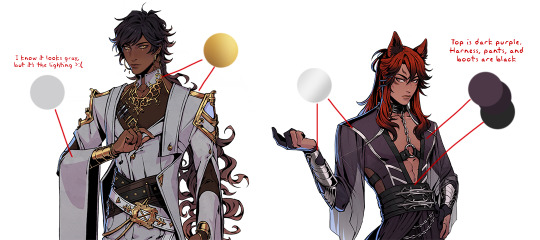
Vere’s design is primarily black and silver whereas Kura’s design is white and gold. Black and White. Silver and gold. Both of these are opposites. Black and white represent the typical opposites like good and evil.
Kuras is a virtuous person at heart. He dislikes dishonesty and has saved both MC and Mhin’s life and they might not be the only people he’s saved because we know he wanders the wastelands. On the other hand, Vere dislikes rules, is a natural liar and causes a lot of trouble whether that be breaking into Kura’s clinic or stealing MC’s key.
Another set of opposites black and white represents is heaven and hell. Kuras is obviously representative of heaven. He is an angel, a divine being. One that supposedly sinned, but he is still a divine being nonetheless. Then there’s Vere, a monstrous beast chained by Senobium. While he isn’t from hell (or maybe he is; we’ll have to find out), he has a hellish motif in his chains. In the Bible, the Chains of Hell are forged by humans who choose to disobey God's commandments. Chains of Hell give Satan the power to control and influence humans. Vere’s hair is also a fiery red. While the notion that hell is a burning hot pit of sulfur is biblically inaccurate, we have come to associate hell with hot temperatures because of how modern media depicts hell. But it also depends on different conceptions of hell you look at. Some shows like Netflix’s Lucifer depict hell as a cold, desolate place and Good Omens depict it as an underground subway of sorts. In Dante’s Inferno, hell is described to have nine “layers”. We know them better as the nine circles of hell, each modeled after a sin. The center of hell in this depiction is burning and hot, but other circles are cold or have completely different environments.
Silver and gold is also mentioned in the Bible. They’re usually mentioned together, but these metals do have different connotations. Gold is thought to be more “superior” than silver is. Even today, gold is used to represent first place and silver is used to represent second place in competitions ranging from school spelling bees to the Olympics.
But biblically speaking, gold was a metal chosen to represent God’s glory. It’s mentioned in Genesis (2:11-12)– “It is the one that flowed around the whole land of Havilah, where there is gold. And the gold of that land is good; bdellium and onyx stone”. Gold is one of the first metals mentioned in the Bible thus being closely associated with God. And from there, the heavens have always been depicted with gold. Golden gates, golden arches, etc. And this is my own interpretation, but seeing as gold can withstand extreme heats without being tarnished, it can also be seen as a “pure” metal, a metal that could withstand hellfire. Supposedly anyway. As for silver…. It’s a bit more “common” than gold would appear to be. If gold represents wealth and the heavens, then silver is associated with trade. Although silver is a precious metal, it is also a fairly mundane metal. You see silver every day whether it’s real or steel– on mechanical pencils, technology, utensils, needles, etc.
Kuras having gold in his design helps to sell the ethereal look of an angel, but it also creates this divine, out-of-reach aura without revealing his true form (which is also probably too much for mortals to handle). His height adds to that as well. He’s so tall that he is literally out of reach. Kuras’s personality also makes him hard to reach. He doesn’t talk much about himself and you can hardly learn anything about him with small talk. He’s mysterious and allusive and Leander has never bought him a drink before. Also he’s a doctor. Not to say that doctors can’t be friendly or have friends, but it does create this professional boundary for many of his patients– and perhaps other people too– making it hard for his patients to connect with him in an intimate/close way.
Vere is of a fairly average height and despite being a monster, he has a very mundane feel to him. Not mundane as in he’s boring, but rather earthly. Very grounded. Compared to Kuras, he is very much within reach by human standards. At least from just talking to him. Yes, he plays around with his food and his words, but you can also garner a lot more from someone who talks a lot than from someone who never talks about themselves at all. From the get go, we knew he didn't like Kuras. In the demo, he makes many of his likes and dislikes clear. Vere feels very human in a way. He also goes out to have fun, drinks, expresses himself whether that be through talking up a pantomime, speaking in a vulgar way, or having a hobby like drawing.

Each character’s chest windows also visually imply something similar about their personalities. Vere has a plunging neckline that exposes a good part of his upper body. Kuras has a bit of a plunge too though it’s not as deep, barely going past his sternum. Kuras’s chest area is also covered by some kind of sleeveless undershirt. It’s sheer, but it still covers his chest. These design choices suggest that Vere is more open about his feelings than Kuras is hence why his chest, or heart, is more exposed. Kuras’s “heart” is covered by a sheer material, meaning you could see some of his feelings but perhaps not all of it as he is guarding them with a barrier of some sort. Keeping his guard up, if you will.
Their chest areas aren’t the only “similar yet different” aspects of their designs. Color schemes and chest areas aside, they both have a robe-like outfit. Their top garments have bell sleeves and this small “train” that drapes down to their legs. Kuras’s sleeves are much longer than Vere’s and they’re detached from the rest of his top, but I think that it’s part of his ethereal look. There’s something classy and elegant about long sleeves.
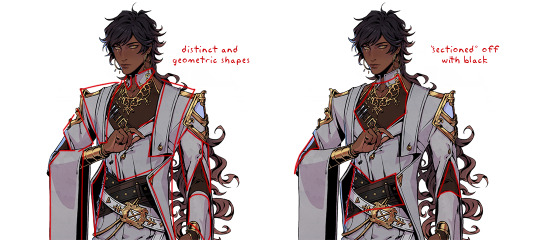
As for the rest of his outfit, it’s pristine and structured. There’s distinct shapes and sections. The design is seemingly symmetrical (except for his belts) which probably suggests that he’s an organized and straight-laced person with an occasional 180 (probably fueled by his fatal flaw)

Vere’s sleeves and most of his top is sheer and flowy. They’re probably made from a comfortable, silky material. In addition to his chest window, he’s also got a thigh window. Vere has a very lax and flirtatious design. The only thing that isn’t so flowy is the belt/collar situation he’s got going on with the Senobium. His center or his chest/heart. His collar is straight and symmetrical. It ties him and his nature down.
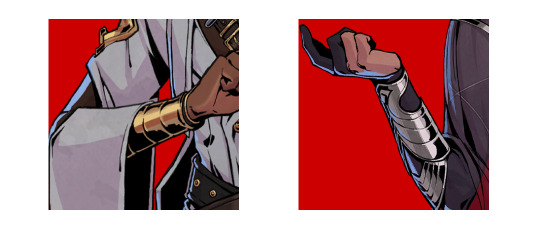
Speaking of being tied down, both Kuras and Vere have vambraces on their forearms. Kuras’s is gold while Vere’s is silver. They’re the only characters to have this. I personally interpret them as manacles. Vere’s vambraces are exposed. He sports them as he does with his collar– out in the open without care. He doesn’t advertise that he’s chained down by the Senobium, but he also doesn’t go to extreme lengths to hide it. Yes, he initially hid his leash from MC, but he also let MC figure out that he was affiliated with them. If people found out, they found out. If they knew, then they knew and he’d make sure they’d know how powerful he is too. On the flip side, Kuras’s vambraces are somewhat shrouded by his long sleeves. In every pose and artwork we’ve seen of Kuras, his vambraces are always half-covered. It’s like you know there is something going on, but you don’t know the full story or feel close enough to ask.
Those vambraces could also be representative of how both characters are prisoners in their own ways. Vere is more literal. He was captured and made to be the Senobium’s pet against his will. He’s somewhat resigned to that life, but of course he wants to escape. Kuras is shackled down by his own ideals. He stays in Eridia because he is compelled by his own guilt. In a way, he chains himself down and gives himself his own punishment. Vere is literally shackled. Kuras is figuratively shackled. Vere is a prisoner of the Senobium. Kuras is a prisoner of his culpability.
The last thing I want to mention is that Vere is affiliated with the Senobium while that place is listed on Kuras’s dislikes. There wasn’t an exact reason for his dislike though. For Leander, we can sort of infer the reasons. He’s a mage, possibly an exile, etc. But there’s not much to go off for Kuras’s revulsion. He is also friends with Mhin who happens to like the Senobium. Does Kuras’s dislike for the Senobium have something to do with Vere or is it something else? Their distaste for one another is mutual according to their relationship charts.
Perhaps if Leander, Ais and Mhin are connected through the Triple Goddess symbol, then Kuras and Vere’s routes might be interconnected since they appear to mirror each other. They’re foil characters!!!
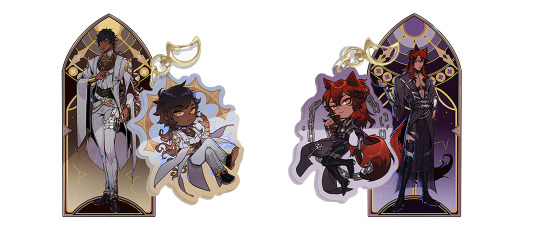
Not just visually but also with their personalities. They’re also marketed with complimentary colors. Colors that are opposites. Kuras is yellow/gold and Vere has purple. I think that means something. Maybe.
133 notes
·
View notes
Text
Elegance of Gothic Cathedrals
First, let me start by saying that architecture is one of my many interests so today I thought I would talk about Gothic architecture mainly in cathedrals.
Gothic architecture has left an indelible mark on the history of design, particularly in its most enduring creations—the cathedrals of Europe. Rising out of the medieval period, these grand edifices are known for their intricate craftsmanship, ethereal beauty, and symbolic power. From the 12th century until the 16th century, this architectural style flourished, transforming the very concept of sacred space.
At the heart of Gothic architecture lies a unique blend of engineering innovation and theological symbolism. Cathedrals such as Notre-Dame de Paris, Chartres, and Cologne are far more than stone structures; they are testaments to humanity’s artistic ambition, cultural heritage, and spiritual aspirations.
The Defining Features of Gothic Architecture
Gothic architecture is immediately recognizable through a few key elements. The most prominent of these are the pointed arches, ribbed vaults, and flying buttresses. These architectural advances not only contributed to the grandeur of the buildings but also solved practical challenges, allowing for higher ceilings and larger windows.
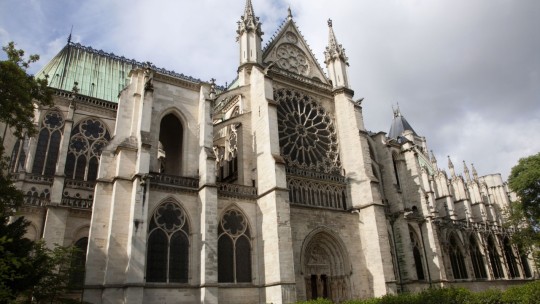
1. Pointed Arches
While the round arches of Romanesque architecture were limited in their ability to support large structures, the pointed arch became a hallmark of the Gothic style. Not only was it more structurally sound, but it also created a sense of verticality that became symbolic of reaching toward the divine. The pointed arches draw the viewer’s gaze upward, fostering a sense of contemplation and reverence.
2. Ribbed Vaults
The ribbed vault was another technological breakthrough of the Gothic era. Instead of relying on heavy walls to support the weight of the building, ribbed vaults distributed the load more evenly, enabling the construction of expansive, open interiors. This innovation allowed for taller, more slender columns, contributing to the light and airy atmosphere of the cathedrals. The skeletal framework of ribs not only supported the structure but also emphasized its intricate geometry, adding layers of visual interest.
3. Flying Buttresses
One of the most iconic features of Gothic cathedrals is the flying buttress. These external supports allowed builders to create thinner walls and incorporate vast stained glass windows, transforming the interior space into a kaleidoscope of light. Flying buttresses also underscored the sense of weightlessness that Gothic cathedrals are known for, making these colossal stone buildings appear as if they were floating. These buttresses were both functional and ornamental, adding to the overall harmony and grandeur of the design.
Symbolism in Gothic Architecture
Gothic cathedrals were not only masterpieces of engineering; they were also deeply symbolic. Every element, from the smallest decorative detail to the towering spires, carried spiritual significance.
1. Verticality and Light
The primary aim of the Gothic architect was to create a space that connected the earthly with the divine. The vertical lines of the cathedrals, their soaring spires, and tall columns were designed to lift the spirit upward, toward the heavens. This sense of verticality mirrored the medieval mindset, in which heaven was a place far above the earth, a place of ultimate beauty and perfection.
Light, too, played a crucial symbolic role. Stained glass windows, often depicting biblical stories or saints, were not merely decorative. They were intended to serve as a divine light, illuminating the interior of the cathedral with vibrant colors, casting a sacred glow that inspired awe and devotion. The famous rose windows, such as the one at Notre-Dame, serve as visual representations of heavenly perfection.
2. The Role of Ornamentation
The level of detail in Gothic cathedrals is nothing short of astonishing. Facades are adorned with intricate carvings, gargoyles, and statuary, all of which tell a story. The carvings of saints, biblical scenes, and even fantastical creatures served both as religious instruction and spiritual contemplation for those who could not read.
Gargoyles, while often seen as grotesque, were symbolic as well. In addition to their practical role in diverting water away from the building, they were thought to ward off evil spirits. Meanwhile, the sheer intricacy of the carvings, such as those seen at Chartres or Reims Cathedral, was meant to reflect the divine beauty and complexity of creation.
Famous Gothic Cathedrals
1. Notre-Dame de Paris
Perhaps the most famous Gothic cathedral in the world, Notre-Dame de Paris exemplifies the best of this architectural style. Constructed between 1163 and 1345, Notre-Dame boasts all the quintessential elements of Gothic architecture, from its twin towers to its flying buttresses. The interior is equally impressive, with ribbed vaults and a stunning rose window that fills the space with colored light.

Tragically, the 2019 fire that destroyed much of the roof and spire has only deepened global appreciation for Notre Dame’s cultural significance. Restoration efforts have focused on faithfully recreating the original design, reinforcing its importance in both architectural and spiritual history.
2. Cologne Cathedral
Cologne Cathedral, located in Germany, stands as one of the tallest Gothic structures in the world, with its twin spires reaching a staggering 157 meters (515 feet) into the sky. Construction on the cathedral began in 1248, but it was not completed until 1880, making it one of the longest construction projects in history. Despite this long timeline, the cathedral’s design remained consistent with its original Gothic vision, with its dark stone exterior, massive flying buttresses, and ornate details.
3. Chartres Cathedral
Chartres Cathedral, located in France, is renowned for its architectural unity and its remarkable collection of stained glass windows. It is one of the best-preserved examples of High Gothic architecture. The cathedral’s West façade, known as the Royal Portal, is adorned with statues of kings, queens, and biblical figures, while the labyrinth embedded in the floor was used as a meditative tool by pilgrims.
Gothic Architecture’s Influence on Modern Design
Even today, the influence of Gothic cathedrals can be seen in modern architecture. Neo-Gothic structures such as New York’s St. Patrick’s Cathedral and London’s Palace of Westminster bear clear marks of their medieval predecessors. The verticality, use of pointed arches, and intricate ornamentation have all been adapted to contemporary sensibilities, proving the timelessness of this architectural style.
Moreover, the spirit of innovation that defined Gothic architecture continues to inspire modern architects. While materials and technologies may have changed, the desire to push the boundaries of design and create spaces that evoke awe and wonder remains as strong as ever.
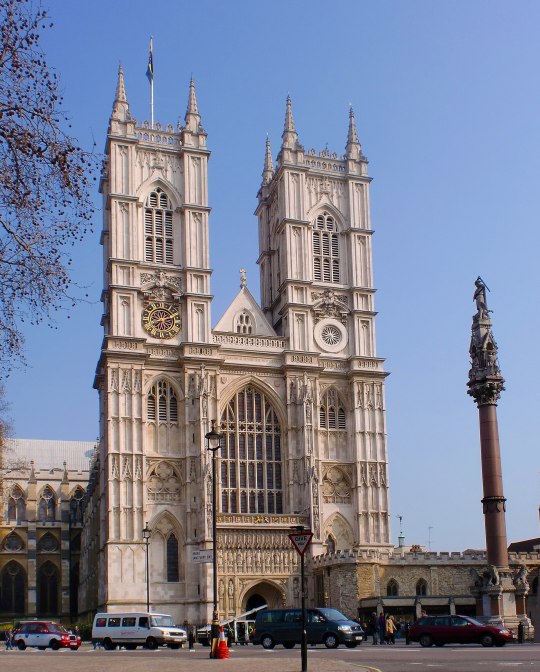
Gothic cathedrals are not only architectural marvels but also profound expressions of faith, culture, and human ingenuity. These towering structures continue to stand as timeless monuments to a bygone era, inviting us to contemplate the divine and to marvel at the artistic achievements of the past. The elegance and grandeur of Gothic architecture remind us of the power of design to transcend time, connecting us to both history and the sublime.
#Gothic Architecture#Cathedrals#Gothic Cathedrals#Notre-Dame de Paris#Cologne Cathedral#Chartres Cathedral#Medieval Architecture#Flying Buttresses#Ribbed Vaults#Stained Glass Windows#Rose Windows#Pointed Arches#Gothic Design#Religious Architecture#Neo-Gothic#Sacred Spaces#Architectural History#Church Architecture#Architecture Symbolism#Gothic Revival
13 notes
·
View notes
Text


All my relatives: Exploring Lakota ontology, belief, and ritual. Posthumus DC (2022)
This is a book all about Lakota traditional beliefs and therefore has a lot of information connected to Mitakuye Oyasin. “At the heart of both Lakota religious continuity and innovation is an underlying animist ontological orientation, a basic way of seeing, understanding, and being in the world that extends personhood— in the form of a soul or spirit— to nonhuman life- forms.” This is expressed with ‘Mitakuye Oyasin’ –meaning ‘all my relatives’ or ‘we are all related’, which refers not only to human kinship but also to the relationship shared by all life-forms, both human and nonhuman, and the reciprocal obligations, responsibilities, and mutual respect that naturally extend from it” (14).

This repeats much of the ideas from similar definitions: belief in the connection between all life, relationships, the power the phrase has. It also gives a lot of words to help define these beliefs in academic language. Another important thing to point out is the way mitakuye oyasin is recognized as being part of Lakota innovation; my goal here is to use mitakuye oyasin to an innovation of queer ecology–hopefully add to the conversation.
“The normative cultural values encompassed by mitákuye oyásʾį are the very foundation of kinship, relational ontology, and the overarching interspecies collective, of which humans are only one hoop, one oyáte ‘people, nation, tribe’, in the company of many others. The key constituents of this animist ontology and worldview, of mitákuye oyásʾį, are persons, a category that extends beyond human beings to nonhuman or other- than- human persons. [...] Importantly, the Lakota worldview sees humans as the least knowledgeable and powerful beings, requiring the most aid and pity, upending the common Western biblical assumption that humans have dominion to rule over all other life- forms and subdue the earth (see V. Deloria 1999, 50; 2009, 99– 100). For the Lakotas, the seed of all life is wakʿą ‘sacrality, mystery, divinity’; ́ hence all life- forms share a generalized interiority, whether human or nonhuman.”
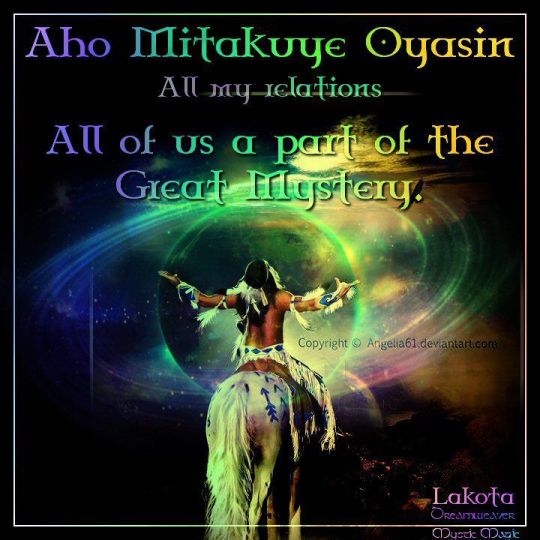
This is important information to support my argument. Queer ecology is very critical of Western beliefs and dichotomies that separate humans from nature and thereby present mankind as the ultimate lifeform (anthropocentrism). There are many essays and articles that examine the influence Christianity has had on the colonialist project (Gaard is the first that comes to mind). The Lakota worldview of being the ‘younger siblings’ of creation are supported by science in that ‘humans’ as a 'species' haven’t existed all that long in comparison to other 'species' and like many indigenous cultures, Lakota people knew the key to knowing nature was to learn from the world around us, as the author later confirms:
“Deloria explains that “the oldest traditions say that humans learned politeness and courtesy from the animals. . . . Generations of elders had already observed the behavior of birds . . . and decided that emulating them was the proper way for humans to act” (V. Deloria 2009, 123). Standing Bear (2006a, 56) substantiates this, writing, “The Lakota enjoyed his association with the animal world. For centuries he derived nothing but good from animal creatures. From them were learned lessons in industry, fidelity, and many virtues and much knowledge.” (50-51)
In the author’s footnotes is Vine Deloria’s examination of mitakuye oyasin that is, I feel, a great support of my claim:
“Vine Deloria refers to mitákuye oyásʾį as the ‘Indian principle of interpretation/observation,’ calling it “a practical methodological tool for investigating the natural world and drawing conclusions about it that can serve as guides for understanding nature and living comfortably within it. . . . We observe the natural world by looking for relationships between various things in it. . . . This concept is simply the relativity concept as applied to a universe that people experience as alive and not as dead or inert” (1999, 34). (Posthumus 2022 p219 f)
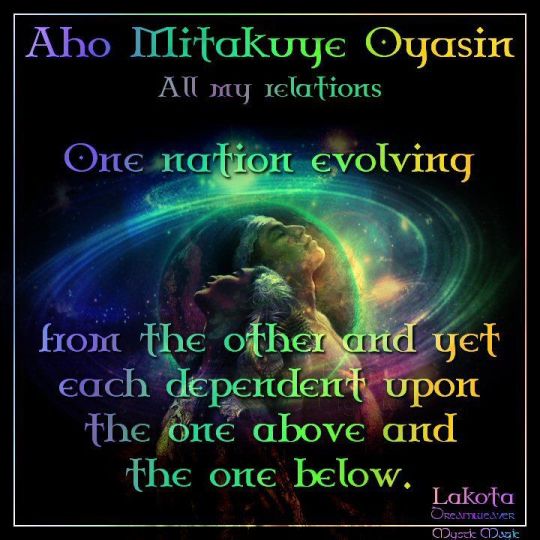
Queer ecology’s goal in many ways is to critique the ways the Western scientific paradigm has created inequity. Many are seemingly searching for solutions and answers to the problems that have been perpetuated by the colonial empire, supported as it is by western science.
While we must always, always be careful of appropriation and misappropriation–I contend that the solutions are not ones that need to be ‘discovered’ or solved in the way that Western science is so often searching for–advancement, the future…but rather, the answers are in what has always been there…and it’s simply a matter of observation.
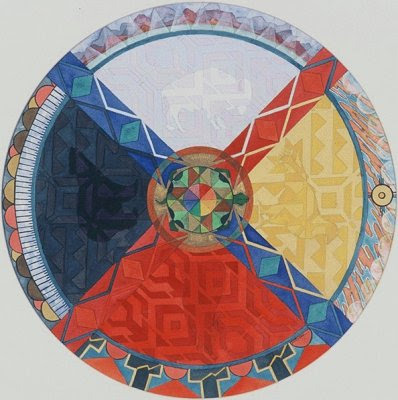
#queer ecology#mitakuye oyasin#queer theory#ecofeminism#critical ecology#colonialism#all my relatives#lakota#indigenous studies#postcolonial theory#ecology#science#traditional ecological knowledge#queering ecology#ecosystems#environment#social ecology#long post
29 notes
·
View notes
Text
“We can too easily think of our charitable works as the same sort of good efforts made by secular people or institutions. But that's a mistake. Scripture gives us a different picture. Note Jesus' famous words in Matthew 25:31-46:
When the Son of man comes in his glory, and all the angels with him, then he will sit on his glorious throne. Before him will be gathered all the nations, and he will separate them one from another as a shepherd separates the sheep from the goats, and he will place the sheep at his right hand, but the goats at the left. Then the King will say to those at his right hand, "Come, O blessed of my Father, inherit the kingdom prepared for you from the foundation of the world; for I was hungry and you gave me food, I was thirsty and you gave me drink, I was a stranger and you welcomed me, I was naked and you clothed me, I was sick and you visited me, I was in prison and you came to me." Then the righteous will answer him, "Lord, when did we see thee hungry and feed thee, or thirsty and give thee drink? And when did we see thee a stranger and welcome thee, or naked and clothe thee? And when did we see thee sick or in prison and visit thee?" And the King will answer them, "Truly, I say to you, as you did it to one of the least of these my brethren, you did it to me." Then he will say to those at his left hand, "Depart from me, you cursed, into the eternal fire prepared for the devil and his angels; for I was hungry and you gave me no food, I was thirsty and you gave me no drink, I was a stranger and you did not welcome me, naked and you did not clothe me, sick and in prison and you did not visit me." Then they also will answer, "Lord, when did we see thee hungry or thirsty or a stranger or naked or sick or in prison, and did not minister to thee?" Then he will answer them, "Truly, I say to you, as you did it not to one of the least of these, you did it not to me." And they will go away into eternal punishment, but the righteous into eternal life.
The biblical scholar Gary Anderson helps us draw two key points from this text. First, charity to the poor has the power to open the gates of heaven. This is because charity is a sacramental act. Jesus tells us that when we give to those in need, we give to him. When we reach out to the poor in love, we encounter him. Recall the story of Saint Martin of Tours, who when confronted with a shivering beggar divided his cloak and gave away half. That night he dreamed of Christ, who was wearing the piece of cloak he'd given away.
Second, we tend to think of works of charity separately from the Mass, but for the early Christians the two were tied intimately together.(13) Anderson explains: "In the Eucharist, one represents the love Christ showed the world by the self-offering of his life. In almsgiving, the layperson has the opportunity to participate in this divine act by imitating God's mercy in his or her daily actions."(14)
Anderson offers us two more ways to think about our works of charity. First, charity is an expression of faith. It declares what we believe about the world and the God who created it. Consider Mother Teresa. People were drawn to her because she lived with a deep trust in God and his love for the poor. Her acts of love proclaimed that God is love: "They reveal to us the hidden structure of the universe."(15) Second, and more radically, Jews and Christians have often thought of charity as giving God a kind of loan. When a woman gave alms to a beggar, she wasn't just giving money to a person. She was making a loan to God. Her acts of charity were like enduring prayers for mercy that the Lord would not ignore.(16)
We mustn't think of this in a crude way, as though we can manipulate God by our good works. That would be pointless. God can't be used as an instrument of anyone's will. Rather, God inspires us to love the poor and then gives us the "reward" that we earn by His help.(17) We call them works of charity, after all, because they're performed with the love the Holy Spirit gives us, and the Holy Spirit is charity itself. The beauty of charity is that it forms both those who give and those who receive, and it grows in the exchange. In giving our love, we're "rewarded" with more love to give.
That's how God's love works: He gives love to us, we respond with acts empowered by that love, and then we and those we love grow in love.”
-Archbishop Charles J. Chaput, Strangers in a Strange Land: Living the Catholic Faith in a Post-Christian World
—
(13)-(17) Anderson, Charity: The Place of the Poor in the Biblical Tradition
4 notes
·
View notes
Note
Hey Avery, I love this blog and the binary-breakers blog. They’ve both been a great help to me as I reconstruct my faith. But I’m struggling with something: my fiancé and I are scheduled to light an advent candle during the Sunday morning service at his church. Initially I was really looking forward to it, but by chance I was curious about how old Mary was when she bore Jesus, and when I looked it up I learned she could have been anywhere from 13-16. Moreover, some traditions put Joseph as being much, much older. It’s just hard not to think in a very . . . sinister direction when considering that context, especially as far as God’s role in this is concerned. What did you learn about this topic in seminary, if anything? Is there any hope that my “problematic” interpretation is unnecessary/invalid?
Hi there! I think it's lovely y'all are going to light an advent candle tomorrow, and I hope it's a meaningful experience! I also totally get your dismay about Mary's age at Jesus's birth.
To start with the facts: yes, Mary was almost certainly a teenager when betrothed to Joseph. The Bible doesn't give any confirmation of her age, but in both ancient Jewish culture and Roman culture, girls were usually married off not too many years after they started menstruating.
When it comes to Joseph's age, I do have some slightly relieving news — he's unlikely to have been the old man he's often depicted as in medieval art. (I actually had a fascinating conversation on this topic with queer Catholic art historian Amy Neville on my podcast that you can read or listen to here!) He almost certainly would have been older than Mary, but it's uncertain how much older.
In ancient Jewish culture, the "ideal" marriage was actually one between a man and a woman who were both in their teens, with an expectation that a man marry by age 20. Being able to support a wife & kids was a key indicator of manhood, so men were expected to get married as young as they could. But in practice, it was more common for men to marry in their late 20s / by age 30, which does mean that their wives would often be a good ten or fifteen years younger than they were.
The Bible doesn't tell us what age Joseph was when he and Mary were betrothed, but it's unlikely he was older than 30, just as it's unlikely she was older than 18.
So maybe that's not quite as discomfiting as the image of a much older Joseph, but by our modern standards, it's still pedophilia. So what do we make of that? And what did God think of that??
__
I believe it is an act of faith to be troubled by elements of scripture that should be troubling, rather than shrugging them off as being "God's will" just because they're in the Bible. I highly recommend Rachel Held Evans' book Inspired on this topic, which has a whole chapter on grappling with difficult biblical texts (you can read a long passage from it here).
While exploring our emotions and giving them holy space, it is also important to accept that biblical cultures are two thousand or more years old — the ancient world had completely different understandings of morality from us. That doesn't mean we shrug off displays of sexism or xenophobia in scripture — bigotry is bigotry, whether an ancient iteration or what we have today — but learning about biblical cultures enriches our understanding of why certain things, like slavery or women having little say in whom they marry, are present in the Bible (and often completely taken for granted by its human authors). It can help us distinguish between what is truly God-ordained, versus what the humans writing down their experience of God presume is God-ordained.
I appreciate how womanist theologian Wil Gafney explores the complexity of appreciating the Bible as an ancient human text while looking for Divine truth "between the lines":
“There is liberation in the gospel even though it is sometimes obscured by the structures of power that benefit from holding people captive. There is also a story in and between the lines of and behind the text we hold so dear that points to a liberation that not even the authors and editors of scripture were able to see clearly or, see their way to record.
Jesus was a rabbi, he would have never wanted us to cling to the letters and syntax of these texts as though they were his very body and blood but rather, his spirit and the Spirit of God, blow through them, ruffling and disturbing them and permitting us to read new truths in and out of them and, not lose sight of the ancient stories that are also part of our shared heritage."
___
When it comes to Mary's young age when betrothed to Joseph and approached by Gabriel to request her "yes" to carrying God's child, your question of God's "role" in that is a vital one to ask.
In Mary's world, a woman without a kyrios, a man to be her protector, was in a very precarious position. Mary has to be betrothed to someone in her teens. We don't know whether God "approves" of this cultural practice, but we can see how God works within this custom to ensure Mary's security throughout her life:
when Joseph plans to divorce her after she becomes pregnant with Jesus, God sends an angel to persuade him to stick by her;
when Jesus is dying on the cross, he ensures that his beloved will protect Mary after he's gone.
Throughout scripture, God largely seems to operate within a people's cultural expectations (with key exceptions, like how God insists Their people treat foreigners the same as members of the group, or when God warns against giving the people a king just because that's what all the other nations have). That's what I see here. Mary must have a husband to be secure in her culture, and I imagine God ensuring that that husband will be one who will treat her well.
__
Then there's the question of God espousing Mary — of the Holy Spirit "overshadowing" her so that she conceives Jesus. What exactly is this "overshadowing" act? Why is God getting a teen girl pregnant?
Again, Rev. Wil Gafney provides words that wrestle out the good news with this complexity. When reading Luke 1, she urges us to sit with our distress at the image of a powerful "male" figure (Gabriel) approaching a teen girl to tell her what's going to happen to her body:
"Sit with me in this moment, this uncomfortable moment, before rushing to find proof of her consent, or argue that contemporary notions of consent do not apply to ancient texts, or God knew she’d say yes so it was prophetic, or contend that (human) gender does not apply to divine beings, Gabriel or God, and the Holy Spirit is feminine anyway. Hold those thoughts and just sit in the moment with this young woman."
Our distress is holy; it shows our connection to a fellow human being, our thirst for justice. Honor what you feel, don't discard your emotions, even while you join them to sociohistorical understanding.
I highly recommend you read Gafney's whole article, but here's a little more from it that balances ancient culture with modern ethics:
"Yet in a world which did not necessarily recognize her sole ownership of her body and did not understand our notions of consent and rape, this very young woman had the dignity, courage, and temerity to question a messenger of the Living God about what would happen to her body before giving her consent. That is important. That gets lost when we rush to her capitulation. Before Mary said, “yes,” she said, “wait a minute, explain this to me.” ... Did the Ever-Blessed Virgin Mary say, “me too?” Perhaps not. A close reading shows her presumably powerless in every way but sufficiently empowered to talk back to the emissary of God, determine for herself, and grant what consent she could no matter the power of the One asking. And yet in that moment after being told by someone else what would happen to her body, she became not just the Mother of God, but the holy sister to those of us who do say, “Me too.” "
Because Mary was a teen girl, an impoverished Palestinian Jew living under empire, she can extend solidarity to people across all time who experience similar oppression, whose bodily autonomy is equally precarious. Just as her son, God in human flesh, extends solidarity to all who have ever been arrested or executed under an unjust state through his crucifixion. Divine power is expressed in and through those whom the world denigrates and discards — that's why God chose Mary, and why Mary in turn chose God.
Sorry this got so long and has a lot of complex stuff to wrestle with. I honor your courage to ask the hard questions, and I hope you are able to take time throughout Advent to keep pondering! There are no easy answers, but wrestling can yield a blessing.
28 notes
·
View notes
Text

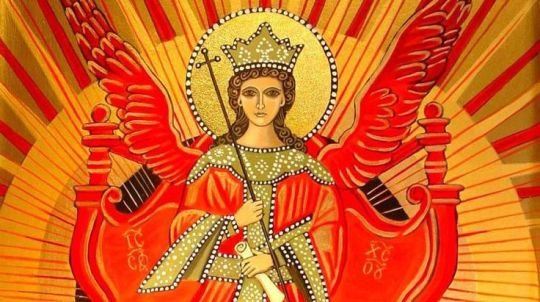

Introduction to the Divine Feminine in Christianity
In traditional Christianity, God is predominantly viewed through the lens of the Father and the Son, which reflect the more masculine attributes of power, strength, and authority. However, esoteric Christian traditions, particularly those found in Gnostic texts, mystical Christian writings, and early church fathers, reveal the often-overlooked presence of the Divine Feminine.
The Divine Feminine is not an afterthought, nor is it secondary to the masculine. Rather, it plays a crucial role in the cosmic balance, wisdom, and spiritual journey. Esoteric Christianity explores the feminine dimensions of the divine primarily through three manifestations: Sophia, the Holy Spirit, and the Bridal Chamber.
These sacred elements highlight the importance of the feminine in both creation and salvation, teaching believers about the unity of opposites, the wisdom of God, and the intimacy between the soul and the divine.
Sophia in Gnostic Christianity
The figure of Sophia (Greek for "wisdom") is central in Gnostic Christianity, where she is often portrayed as the feminine manifestation of divine wisdom. She is a complex figure with deep roots in both Jewish and early Christian thought, but her role in Gnosticism reveals a profound esoteric understanding of God’s nature.
In Gnostic cosmology, Sophia is often regarded as the first emanation of God, sometimes referred to as the Mother of the Cosmos. She exists as a divine intellect that is directly involved in the unfolding of creation. According to texts like the Apocryphon of John and The Gospel of Sophia, Sophia’s role is to bring wisdom into being, and through her actions, the world is created.
However, Sophia’s story is also marked by tragic fallenness. In many Gnostic texts, Sophia’s yearning to know the unknowable leads her to act alone, resulting in her creating the material world. This world, according to the Gnostics, is flawed because it is born from Sophia’s attempt to separate from the Divine Source (the Father). This fall, however, is not permanent. Sophia’s journey represents the process of redemption—the return to her divine origin, just as humanity, in Gnostic thought, must return to God.
Sophia’s fall symbolizes spiritual ignorance and the entrapment of the soul in the physical world. Her ultimate redemption is the key to human salvation, showing that through wisdom (Sophia), the soul can ascend and reunite with God.
Sophia’s Role in Creation
In Gnostic thought, Sophia is not a mere bystander in creation; she is an active participant. She is often understood as the first thought of God, the logos or divine blueprint, which is the template through which the world is fashioned. Her role as divine wisdom means she has the capacity to bring order and meaning to creation. In some Gnostic texts, Sophia is associated with the Holy Spirit, who continues to carry out the work of creation and salvation within the cosmos.
Sophia and the Tree of Knowledge
Sophia’s connection to the Tree of Knowledge of Good and Evil in the Garden of Eden is a key symbol in esoteric Christianity. Unlike the traditional interpretation, where the Tree represents sin, in esoteric Christianity, it symbolizes the wisdom of Sophia—knowledge that has the power to awaken humanity to its true divine nature. The serpent in the Garden, often seen as a symbol of temptation or evil, in the Gnostic tradition, is also a symbol of Sophia’s wisdom—her voice calling humanity to rise above the material realm and into a higher understanding of divine truth.
Sophia in Biblical Texts
Though Sophia doesn’t appear explicitly in the canonized scriptures of the Bible, elements of her can be found throughout the Old and New Testaments, particularly in the Book of Proverbs. In Proverbs 8:22-23, Sophia speaks of her role in the creation of the world:
"The Lord possessed me at the beginning of His work, the first of His acts of old. Ages ago I was set up, at the first, before the beginning of the earth. When there were no depths I was brought forth..." Proverbs 8:22-23
This passage paints Sophia as an eternal being, present before creation itself, participating in the divine ordering of the universe. This understanding of Sophia helps bridge the gap between traditional Christian thought and Gnostic esotericism.
Sophia as the Wisdom of Christ
In the New Testament, Christ is often referred to as the embodiment of divine wisdom (the Logos), but this wisdom is inextricably linked to Sophia in the Gnostic tradition. Christ’s wisdom is not merely intellectual but is deeply transformative, offering redemption to the soul. In this sense, Sophia, as the divine wisdom, is closely intertwined with the person of Christ, revealing that the Divine Feminine is just as central to God’s plan of salvation as the masculine Christ.
The Holy Spirit
In most Christian traditions, the Holy Spirit is understood as an invisible force or divine presence that empowers and inspires believers. In esoteric Christianity, the Holy Spirit is frequently associated with the Divine Feminine, and her qualities emphasize nurturing, comfort, and spiritual transformation. The Holy Spirit is not an abstract, impersonal force, but a living presence, fully involved in the believer’s journey toward spiritual awakening.
The Holy Spirit is often depicted as a nurturing mother, guiding the believer through the inner life of contemplation and prayer. Like a mother who comforts her child, the Holy Spirit offers the soul warmth and encouragement as it grapples with the challenges of the material world.
The Paraclete
The term Paraclete (Greek for "helper" or "advocate") used to describe the Holy Spirit emphasizes her role as an intercessor and guide. She speaks to the soul, calling it to a deeper union with God. This relationship is reminiscent of a spiritual marriage, where the believer becomes the bride and the Holy Spirit acts as the bridegroom, guiding the soul to union with Christ.
Just as Sophia’s wisdom leads to salvation in Gnosticism, the Holy Spirit brings the believer into an intimate relationship with God through Christ. She convicts, transforms, and nurtures, guiding the soul towards sanctification. The Holy Spirit is a presence that moves the believer to rise above the worldly distractions and distractions and return to the eternal, transcendent nature of God’s kingdom.
The Bridal Chamber
The concept of the Bridal Chamber is one of the most profound and mystical elements within esoteric Christianity. This sacred space symbolizes the spiritual union of the soul with God, bringing together the masculine and feminine aspects of the divine.
In texts like The Gospel of Philip and The Gospel of Thomas, the Bridal Chamber represents the sacred space where the believer enters into mystical union with God. In this union, the soul is transformed through the love of Christ and the wisdom of Sophia, completing its spiritual journey. The Bridal Chamber is not a physical space but a spiritual state where the soul is purified, receiving both wisdom and divine love.
The Bridal Chamber represents the spiritual rebirth of the believer, transcending the duality of body and spirit, masculine and feminine. The process of spiritual awakening in this chamber involves divine initiation, where the soul undergoes a profound transformation. This sacred union mirrors the mystical marriage between the soul (the bride) and Christ (the bridegroom), which is central to the Gnostic path of salvation.
Embracing the Divine Feminine
By embracing the Divine Feminine, believers open themselves to the wisdom of God that transcends the boundaries of gender and material existence, allowing them to experience both the masculine and feminine aspects of God in harmony. The Divine Feminine is not only a symbol of creation but an active participant in the redemptive process, drawing the soul toward a deeper understanding of God and a fuller experience of divine love.
Citations and Sources for Further Readings
Robinson, James M., ed. The Nag Hammadi Library. HarperOne, 1990. The Gospel of Philip, translated by Wesley W. Isenberg. In The Nag Hammadi Library, edited by James M. Robinson. The Gospel of Thomas, translated by Thomas O. Lambdin. In The Nag Hammadi Library. Pagels, Elaine. The Gnostic Gospels. Vintage Books, 1979. Trobisch, David. Sophia, the Feminine Divine in Gnostic and Early Christian Thought. Gnostica Press, 2003. Lossky, Vladimir. The Mystical Theology of the Eastern Church. St. Vladimir's Seminary Press, 1957. Williams, William R. The Paraclete: A Study in the Doctrine of the Holy Spirit. The Macmillan Company, 1922. Emmerich, Anne Catherine. The Feminine in the Sacred: From Sophia to the Holy Spirit. Light of Christ Press, 2010. The Holy Bible, Proverbs 8:22-23. (King James Version, New Revised Standard Version, etc.). The Wisdom of Solomon. Catholic and Orthodox Bibles, Deuterocanonical books
#christian blog#christian faith#religion#christianity#religionblr#studyblr#esoteric#esoteric studies#esoteric christianity#esoterist#esotericism#gnostic texts#gnostic christianity#gnostic gospels#gnosticism#gnostic teachings
3 notes
·
View notes
Text
Education As A Help To Life
Maria Montessori's philosophy of education stands as a profound testimony to the role that education plays in the formation of human beings. Rooted deeply in an understanding of humanity's connection to God and the natural world, Montessori’s approach challenges us to see education not simply as the transmission of knowledge but as a process of self-formation, adaptation, and reconciliation to our Creator.
Montessori, in the words of Mario Montessori Jr., emphasized that “The great power of man is that he adapts to every part of the environment and that he modifies it. For this reason, every man that is born must prepare his personality anew.” At birth, the child is not born with the characteristics that define his place in society. Instead, he is given a blank slate, a divine potential to create and adapt to the world around him. Education, then, is not merely about knowledge acquisition but about forming the child’s character in response to God’s creation, aligning the child’s natural development with the purpose and meaning inherent in the world.
This view resonates deeply with the biblical concept found in Proverbs 22:6, “Train up a child in the way he should go: and when he is old, he will not depart from it.” As parents, guides, and adults, we bear responsibility for guiding the child, knowing that we can shape and mold the emerging soul. Yet, Montessori also cautioned that while we are responsible for the child’s growth, we must be careful not to overpower the child’s emerging personality. As she noted, “One must have a warm personality when working with children. However, one should be careful not to overpower the emerging personality of the child and get in the way.” This careful restraint is essential in cultivating an environment where the child can act upon his inner urges and develop self-direction.
Montessori viewed the child as a builder—a constructor of his own identity and understanding. This construction happens naturally when children are placed in the right environment—an environment that encourages respect, exploration, and self-construction. The child is not passive; rather, he is actively engaged in shaping his personality and learning, which aligns with the biblical view of humans as active agents in God’s creation, called to reflect His image in how we grow, learn, and interact with the world.
In this context, education becomes an aid to life. It is not an external set of rules but a guiding principle that aligns the child’s innate tendencies with the greater purposes of life. Education, then, becomes a help to life when it serves the child’s development and growth in harmony with God’s creation. Montessori believed that education should be designed to follow the child, respecting his natural development and rhythms, helping him learn through experience, observation, and exploration—free from the hindrances of adult-imposed limitations.
Montessori’s educational philosophy emphasizes the key role of adults in shaping the educational environment. The adult’s job is not to impose but to serve the child’s development, to provide the tools, structure, and support that allow the child to grow in freedom. This is a calling that mirrors the Christian life, where we are called to serve one another—not as overlords but as stewards, guiding others in the ways of truth and love. The task is to help the child find his way, to recognize his gifts, and to help him adapt to the world around him, all the while nurturing his relationship with God and His creation.
In this framework, education becomes a tool of healing for both child and adult. When we bring children into environments that respect their natural development, we also help ourselves. As Montessori suggested, “We must eliminate the weeds that hinder the child, whether it is from within ourselves, our own traumas or beliefs,” and this process of self-reflection can lead to a kind of healing. By stepping outside of our own biases, fears, and frustrations, we create space for the child to grow and heal in a way that reflects the Gospel message of reconciliation—both with God and with one another. In this way, education becomes a mutual process, a reconciliatory act, where both child and adult are shaped and formed more into the image of God.
In a Reformed Presbyterian understanding, the environment is not neutral; it is part of God’s creation and is to be respected and used wisely. Montessori’s recognition of the child’s need for a prepared environment aligns with this. She saw the environment as the stage where God’s design unfolds, where children are not merely passive recipients of information but active participants in the world around them. The relationship between the child and his environment is central to his learning, as it helps him adapt and prepare his personality anew, aligning himself with the world as it was created by God.
This process, however, is not without challenges. Children must not be dominated by the personality of the adult, nor must their natural inclinations be stifled. Rather, adults are to provide the guidance and support necessary to ensure that the child’s development takes place in the freedom of a God-ordained environment that is rich with opportunities for exploration, learning, and self-expression.
Montessori’s view of the child as a builder of his own character echoes the biblical truth that humanity was created in God’s image and endowed with the ability to shape and form the world around them. Just as God gives humans the creative power to act as His stewards on earth, children have the innate power to build themselves, their relationships, and their understanding of the world. This process is not a passive journey but an active engagement with God’s purposes for the individual.
In conclusion, education as an aid to life is not just a tool for personal development but a means of aligning the child’s natural growth with God’s divine plan. It is through education that the child learns to adapt, to build, and to construct his identity in response to the environment around him. And as adults, we have the responsibility to guide this development carefully, offering love, restraint, and support as we nurture the child’s relationship with God and His creation. Montessori’s approach challenges us to remember that education is not a mere academic pursuit but a sacred task of forming human beings who reflect the image of God, live in peace, and contribute to a better world.
2 notes
·
View notes
Text
youtube
Escaping Pharaoh's Matrix | Confronting Our Inner Pharaoh What if Egypt isn’t just a place in history—but a spiritual matrix you’re still trapped in? In Escaping Pharaoh's Matrix, Derek from Shalom Macon explores the deeper meaning of Passover, revealing how Pharaoh symbolizes the voice within that enslaves us with fear, shame, and false identity. What does it mean to truly "leave Egypt"? How do we confront the Pharaoh within? And what if our deepest struggles hold the key to divine redemption? Join us on this powerful journey into the heart of the Exodus story—and your own. Please visit our website to get more information: https://ift.tt/iBwEr3j ✅ Important Links to Follow ✨ Discover Jesus in His true Jewish context with The Jewish Jesus series here: https://ift.tt/F5kned6 ✨ Explore the Repaving the Romans Road series for the deeper Jewish context of salvation here: https://ift.tt/P7DbMcZ ✨ Get into the 5-Minute Torah series for quick, powerful insights into the weekly Torah portion here: https://ift.tt/WxzEdt8 🔔𝐃𝐨𝐧'𝐭 𝐟𝐨𝐫𝐠𝐞𝐭 𝐭𝐨 𝐬𝐮𝐛𝐬𝐜𝐫𝐢𝐛𝐞 𝐭𝐨 𝐨𝐮𝐫 𝐜𝐡𝐚𝐧𝐧𝐞𝐥 𝐟𝐨𝐫 𝐦𝐨𝐫𝐞 𝐮𝐩𝐝𝐚𝐭𝐞𝐬. https://www.youtube.com/@Shalomacon/?sub_confirmation=1 🔗 Support Us Here! https://ift.tt/urgpQnt 🔗 Stay Connected With Us. Facebook: https://ift.tt/QjSVd9B Website: https://ift.tt/iBwEr3j 📩 For business inquiries: [email protected] ============================= 🎬Suggested videos for you: ▶️ https://www.youtube.com/watch?v=mbRsb3erMec ▶️ https://www.youtube.com/watch?v=t0eCU627KJs ▶️ https://www.youtube.com/watch?v=iRHAEVXC3To ▶️ https://www.youtube.com/watch?v=HpAuUmrodmc ▶️ https://www.youtube.com/watch?v=ULY1-9NggYQ ▶️ https://www.youtube.com/watch?v=7gCNEfI_IMA ▶️ https://www.youtube.com/watch?v=ecPQCu-kTo4 ▶️ https://www.youtube.com/watch?v=G1kroV32sNI ▶️ https://www.youtube.com/watch?v=uHxT47k6cak ▶️ https://www.youtube.com/watch?v=_XfgKNx77to ▶️ https://www.youtube.com/watch?v=OJiW2gvusVE ▶️ https://www.youtube.com/watch?v=xbcJwTfJVxk ▶️ https://www.youtube.com/watch?v=BgdlU0h0pmc ▶️ https://www.youtube.com/watch?v=pT4kknKAY4A ▶️ https://www.youtube.com/watch?v=uO9ky0FEj5A ================================= ✅ About Shalom Macon. Welcome to Shalom Macon -- a vibrant community of Jewish and Gentile believers in Messiah Yeshua, worshiping together in person in Macon, Georgia, and online worldwide. We provide a place where Jewish believers can honor their heritage and Gentile believers can deepen their understanding of the Messiah in His Jewish context. Our teachings go beyond the surface, offering meaningful insights into Jesus, the Bible, Israel, and the Kingdom of God. Jesus was and always will be a Jew, and understanding His words through a Jewish lens brings deeper clarity. Join us live every Saturday at 11:00 AM Eastern for worship and teaching. Shalom Macon is here to help you grow. For Business inquiries, please use the contact information below: 📩 Email: [email protected] 🔔 Looking to deepen your faith and understanding of the Bible? Subscribe for powerful biblical truths, Messianic insights, & the true Jewish context of Jesus and His teachings! https://www.youtube.com/@Shalomacon/?sub_confirmation=1 ================================= 🔎 Related Phrases: “Pharaoh lives in your mind.” “Egypt wasn’t just a place—it’s a pattern.” “Mitzrayim is the matrix. Can you escape it?” “Freedom begins where fear is confronted.” “Pharaoh whispers lies. Moses speaks truth.” “What if your greatest oppressor is within?” “Come unto Pharaoh—confront the false self.” “Slavery ends where identity begins.” “You were never meant to stay in Egypt.” “Let my people go... starts with you.” Hashtags: #Passover #Exodus #Pharaoh #SpiritualFreedom #MessianicJudaism #InnerHealing #TorahTeaching #ShalomMacon #Yeshua #FreedomFromEgypt #Pesach via Shalom Macon https://www.youtube.com/channel/UCSXxCAqjFHtmNWLDiAndiLg April 02, 2025 at 05:10PM
#confidence#messianic#torahportion#yeshua#jewish#holyspirit#christology#spiritualtransformation#faith#Youtube
2 notes
·
View notes
Text

Allow Christ's Peace To Govern Your Heart
The phrase "thank you" is well known in the English language. From the family dinner table to government negotiations, these two magic words have proven invaluable in conveying worldwide honor and respect. But the power is not simply in the words but the sentiments behind them. The gratitude that accompanies a genuine "thank you" is something the giver and receiver can both enjoy.
One of the keys to contentment in our lives is gratitude. Gratitude is more than an eloquent speech; it is an attitude of the heart. Let's be clear: there is no fooling the God of the universe. He knows you inside and out. In fact, the Bible says God desires us to come before him with an offering of thankfulness, not simply to pay Him lip service (Psalm 50:23). The Hebrew term for gratitude is hakarat hatov, which literally translates to: "recognizing the good." The spirit of ingratitude will creep into your life if you criticize what you have and compare it with someone else. Instead, choose to see the good God is doing in your own life at this very moment. Genuinely thanking God for everything He has done opens your eyes to recognize His divine care and protection.
It is important to note that gratitude and peace are two sides of the same coin. Biblical peace is characterized as a wholeness of the body, a right relationship or harmony between God and his people, prosperity, victory over one's enemies, and the absence of war.
Where do you need God's peace today? Start by thanking Him for every good thing you have in your life, and God's peace will watch over your heart and mind. The contented life is a grateful life full of peace, where you can know without a shadow of a doubt that your past, present, and future are safe in the hands of a God who loves you with everlasting love.
---
By: Jacquie Trivino
5 notes
·
View notes
Text
How Manifestation is Linked to Christianity 🤍🦢

Manifestation—the idea that your thoughts, beliefs, and words shape your reality—might seem like a modern spiritual concept, but it’s deeply rooted in Christian principles. At its core, manifestation is about faith, the power of your words, and the divine authority God has given each of us to create a life aligned with His will.
Let’s explore how manifestation and Christianity connect, showing that these practices can harmonize beautifully for those who hold faith in God and His teachings.
The Power of Words: “Life and Death are in the Power of the Tongue”
One of the most direct links between manifestation and Christianity is found in the Bible’s teachings on the power of words. Proverbs 18:21 says:
“The tongue has the power of life and death, and those who love it will eat its fruit.”
This verse illustrates a fundamental principle of manifestation: your words carry immense creative power. When you speak life—affirming blessings, abundance, health, and love—you align yourself with positive outcomes. Conversely, speaking negativity or doubt invites those experiences into your reality.
Manifestation emphasizes affirmations, and Christianity encourages speaking words of faith and blessings. Both recognize the ability of your words to shape your reality.
Faith: The Foundation of Manifestation and Christianity
Faith is the cornerstone of both Christianity and manifestation. In Hebrews 11:1, faith is defined as:
“Faith is the substance of things hoped for, the evidence of things not seen.”
This verse perfectly mirrors the principle of manifestation, which teaches that you must believe in your desires even before they manifest physically. Whether praying to God or visualizing your dreams, the process requires unwavering faith that what you desire will come to pass.
Jesus Himself emphasized the power of belief in Mark 11:24:
“Whatever you ask for in prayer, believe that you have received it, and it will be yours.”
In manifestation, this is known as “living in the end.” You act, think, and feel as though your prayers have already been answered.
God’s Gift of Free Will and Co-Creation
Christianity teaches that we are created in God’s image (Genesis 1:27). As His children, we inherit His creative abilities. Manifestation aligns with this truth by teaching that we are co-creators of our reality, working alongside God’s will.
God has given us free will, which means we can shape our lives through the choices we make, the thoughts we entertain, and the faith we hold. Manifestation is not about replacing God; it’s about working with Him, using the authority He has already given us to bring His blessings into our lives.
Prayer as a Form of Manifestation
Prayer and manifestation share a common thread: both involve setting an intention, believing in the outcome, and trusting in a higher power. In Christianity, prayer is the act of communicating with God, asking for His guidance and blessings. Manifestation involves a similar process, with a focus on faith and gratitude.
Philippians 4:6-7 says:
“Do not be anxious about anything, but in every situation, by prayer and petition, with thanksgiving, present your requests to God.”
Gratitude is a cornerstone of manifestation. By thanking God for blessings before they arrive, you strengthen your faith and align yourself with His promises.
Biblical Affirmations for Manifestation
Scripture is filled with affirmations that can align your mindset with God’s promises:
“I can do all things through Christ who strengthens me.” (Philippians 4:13)
“For I know the plans I have for you,” declares the Lord, “plans to prosper you and not to harm you, plans to give you hope and a future.” (Jeremiah 29:11)
“The Lord is my shepherd; I lack nothing.” (Psalm 23:1)
Repeating these affirmations strengthens your faith and aligns your thoughts with God’s will for abundance, protection, and success.
Trusting God’s Timing
One key difference between manifestation and secular approaches is the emphasis on surrendering to God’s timing. Manifestation often teaches that you should detach from the “how” and “when” of your desires, and Christianity reinforces this by reminding us that God’s timing is perfect.
Ecclesiastes 3:11 says:
“He has made everything beautiful in its time.”
While manifesting, Christians can trust that their desires will unfold according to God’s divine plan, knowing He works all things for good.
Final Thoughts: Manifestation as a Tool of Faith
Manifestation and Christianity are deeply connected through shared principles of faith, the power of words, and co-creation with God. As a believer, you can integrate manifestation into your faith by:
Trusting in God’s Plan: Align your desires with His will, knowing He wants you to live a life of abundance and joy.
Speaking Life Over Your Reality: Use affirmations and prayers to declare blessings and abundance.
Living in Faith: Believe that your prayers and desires are already fulfilled, even before they appear.
Darling, you are not separate from God’s power—you are His child, created in His image, and gifted with the ability to shape your life. Manifest boldly, pray fervently, and know that the divine is always working in your favor. 🤍
~Lady.K
#manifestationandfaith#christianmanifestation#createyourreality#youaregod#law of assumption#loa tumblr#manifestation
2 notes
·
View notes
Link
#biblicalteachings#Christ#David#divinewisdom#rejectingearthlypleasures#Solomon#Sophia#spiritualgrowth#spiritualjourney#wisdom
2 notes
·
View notes
Text
THE EVENT UNLEASHED! BIBLICAL PROPHECIES, GLOBAL BLACKOUT, MARTIAL LAW, WWIII, TESLA’S SECRET TECH, AND GESARA’S MASSIVE WEALTH TRANSFER!
The clock is ticking toward a monumental shift that will reshape the world as we know it. What appears to be the brewing of World War III is merely a facade for a deeper, more sinister agenda—a global purge to dismantle the Luciferian strongholds that have ensnared humanity for centuries.
This is not merely another war; it’s a divine intervention designed to obliterate the satanic infrastructure ruling over us. This global cleansing will utilize key military targets not as foreign armies or states but as symbols of Illuminati power—the Vatican, Buckingham Palace, the White House, and even CERN with its dark experiments.
The Event marks the beginning of this massive upheaval, with GESARA funds paving the way for rebuilding a cleansed world. This is about resetting the financial system, moving away from Rothschild-controlled banks to rainbow Treasury notes backed by actual precious metals.
The destruction of 34 key sites linked to the global cabal’s power will be executed using Rods of God and Directed Energy Weapons. This isn’t just conspiracy theory; it's strategic dismantling, as seen in recent strikes on Tesla Bitcoin servers and data centers.
The coming chaos will extend beyond a simple currency reset. The impending stock market crash and the implementation of global martial law are not mere economic downturns but a deliberate takedown. This will usher in a new world under emergency measures, radically different from what we’ve known.
As the market crashes, so too will the old financial systems tied to the elites. The portrayed third World War, with its nuclear sirens and mass panic, is merely a distraction from the true agenda: the establishment of a new system aligned with divine justice.
Military tribunals and secret courts are already in action, executing a global purge of betrayal against humanity. These are not rumors; they are realities, with executions and confessions unfolding far from the public eye, unreported by mainstream media.
Project Odin, part of the Quantum Starlink system, will neutralize Mossad’s media control, erasing their influence and ending their ability to manipulate the truth. This will coincide with a global blackout essential for transitioning to Tesla Energy—an energy system free from the control of the cabal, signaling the end of their reign.
This blackout is strategic, aimed at severing the cabal’s last lines of communication and disinformation. It's a necessary step to reveal the full extent of what has been hidden from public view.
But the transition won't be smooth. The elites will stage a fake World War III, complete with nuclear threats, to cling to their fading power. They will claim it’s for our safety, but it’s their final act of desperation.
This is not just military training; it's preparation for the largest military operation in history—the final battle between good and evil. Castles will fall, royal families will be dethroned, and corrupt institutions will crumble.
The event we’ve been warned about is unfolding. The signs are clear, marking the shift to a new era under GESARA, revealing hidden truths and empowering the people, not the elites. The storm is here, and there’s no turning back.
Prepare for the most tumultuous period in human history. The war for our freedom—and the soul of humanity—is now.
2 notes
·
View notes